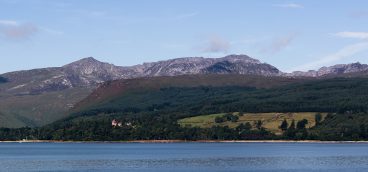The Changing of the Clan

That evening, after our tour of Arran and another whisky-soaked evening, Charles walked me outside Strabane. He was carrying, for some reason, a large bowl of eggs he’d taken from the refrigerator.
“These eggs,” he told me, “are very special Isle-of-Arran eggs from our own chickens. Handled properly, they’re virtually indestructible. Wait here.” Baffled by all this, I did as I was told, while Charles walked around to the other side of the large house. “All set?” he called out.
“Ready as ever!” I called back.
“Heads up for the egg!” he cried, and almost immediately an egg came flying over the roof of the house and landed in the stiff Arran grass at my feet. The damned thing was perfectly intact.
“Pretty remarkable, no?” said Charles, returning to my side of the house. “Want to give it a try?”
I selected an egg from the bowl and sent it sailing over the roof of Strabane. We then walked around the house and there was my egg, lying in the grass and cracked to pieces.
“You’re not tossing it right,” Charles said, and for the next hour we practiced throwing eggs over the roof of Strabane. All Charles’ eggs landed intact and all my eggs landed broken. “You’re hopeless,” Charles said, and we went inside for more whisky.
In the living room Lady Jean cast a stern eye on Charles, then said to me, “Pay no attention to that fool. The trick’s to put the egg under your armpit for a minute before you toss it. Warm eggs don’t break.” Charles laughed uproariously.
That night I wrote a poem about this bizarre event, called “Egg Tossing in Scotland.” Fortunately, it has been lost.
* * *
The next morning Charles and I walked around Brodick, inspecting the many small-but-terminally-charming houses Lady Jean had let out to the townspeople. Along the way, Charles continued his story of the “emergency.”
Arran had come into the hands of the Dukes of Hamilton back in 1503, Charles told me. It seems that James, the 2nd Lord Hamilton, had played cupid, helping arrange the marriage of King James IV (Hamilton’s cousin) to Margaret Tudor. The Earldom of Arran was his reward.
All went well until the early nineteenth century, when the 10th Duke of Hamilton began evicting tenants from the land. This event, which happened across Scotland, is known as the “clearances.”
What was happening, according to Charles, is that for centuries Scottish farming had been operated on the so-called “run-rig” system, that is, the land was open and used commonly by everyone, although each year specific areas were allocated to individuals to be farmed.
But during the Agricultural Revolution—part of the First Industrial Revolution—rapid improvements were made in farming techniques and equipment. The rapidly growing cities of London, Manchester, Glasgow, etc. needed cheap food and the new technologies were making that possible.
However, the new farming methods required a certain minimum amount of tillable acreage to be economic. On Arran, as in many places in Scotland, the tiny fields assigned to farmers by the run-rig system were far too small. Something had to give, and it’s only a slight exaggeration to say that either the people in the big cities were going to starve or the small crofters were going to starve. Progress suggested the latter course and that’s the course the 10th Duke took. He would evict twenty or thirty families in one section and enclose the land to make one larger farm. Then he would do the same with another section and so on.
On the other hand, the Duke didn’t want to see his fields dotted with the rotting corpses of his starved former tenants, so he suggested they emigrate to Canada, and even paid half the cost of their transport.
The actions of the 10th Duke, and of his contemporary lords across Scotland, outraged the Scottish people not merely because of its cruelty, but also because it violated the principle of dùthchas, according to which clan members had an inalienable right to rent land from the clan chiefs (the dukes).
The dùthchas system stretched far back into the Middle Ages. With no strong central government to maintain order, the clans were the major social unit in Scotland. Clanship offered protection to the clansmen, who repaid the clan chief with service (including military service) and in-kind rent.
The chiefs, however, gradually stopped thinking of themselves as “chiefs owing a duty to the clansmen,” and started thinking of themselves as simple economic landlords—that is, lords of the land. If it made sense to move tenants off the land in order to form larger, more economic units, that’s what they would do.
“Do you understand,” Charles asked, “why I’m telling you all this?”
“I have a sneaking suspicion,” I said, “that it’s relevant to the situation Lady Jean faces today.
“It does,” said Charles. “When Nanna died [i.e., Lady Jean’s mother], the family had done no estate planning at all. Like most of the British aristocracy, Lady Jean and her mother had been illiquid-house-and-land-rich, but liquid-cash-poor. There was no way to pay the death duties.”
Lady Jean had to deed Brodick Castle over to the Scottish National Trust in lieu of death taxes, and on draconian terms at that. Lady Jean was forced to leave the castle with nothing but the shirt on her back, leaving behind personal photos, mementos and all other personal property.
If Lady Jean wished to throw a dinner party—say, in honor of her distinguished American guest from Pittsburgh—she had to write a letter to the Trust asking to borrow her own china and silver service.
“In short,” said Charles, “Mum’s broke. All she has is the land, and all the land’s held by the tenants. If we attempt another ‘clearance’ the people will hang us from the nearest mountain ash.”
Thus it was that, as per my boss’s instructions, I had gone to Arran without dilly-dallying, I had treated Lady Jean respectfully (not counting the upchuck), and now I had gotten almost to the bottom of the “emergency.” What I could do to “fix it” was something else altogether.







